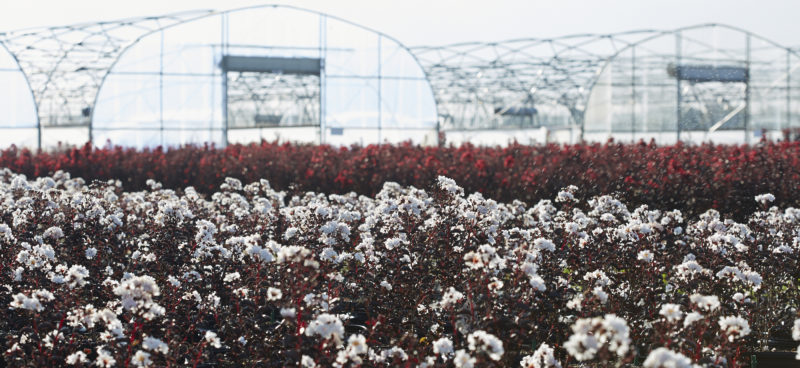
Shrubs Are Perennials Too
Over the past several years, many nurseries and greenhouses have added perennials into their product lines. However, there have been fewer nurseries adding annuals or greenhouses adding woody ornamentals to their product offerings. In this article, I’d like to focus on how traditional perennial growers and greenhouses could easily add shrubs into their programs; after all, shrubs are perennials too.
Before looking at how to add shrubs into an annual or perennial program, let’s quickly look at the differences between herbaceous perennials and shrubs. Herbaceous perennials are plants that complete their life cycles in two or more years and typically lose their above-ground foliage in the winter. Shrubs, often referred to as woody ornamentals, are actually pretty similar to herbaceous perennials except they retain their wood stems during the winter.
I suspect many growers have this idea that shrubs have very long grow times and often require two or more years for plants to reach a marketable size. Although this may be true with some shrubs, many can be grown in one year or less much like the majority of the perennials growers produce.
GETTING STARTED
Several shrubs are best to grow like a traditional perennial. This entails planting them in the summer or fall, over wintering and flushing them to a marketable size in the spring. The main purpose for starting certain shrubs the year before they are to be sold is to allow them time to bulk up. It’s also not uncommon to plant in the late spring or early summer the year before the plants are to be sold when growing shrubs with slow growth rates or when producing them in large container sizes.
The other approach that works with numerous shrubs is to quick crop them or to plant them during the late winter or early spring the same season they will be sold. This option usually required an older, larger and more expensive liner, but greatly decreases production times, maintenance costs and decreases the risk of overwintering losses.
There is a wide range of liner sizes available to use as starting materials. Since most shrubs are vegetatively propagated, it’s rare to find starting materials smaller than 72-cell sized liners. Liner sizes commonly available range from 2-inch to 4 ½-inch liners or pots (40-cell cell trays to one-quart sized containers). It’s also common to upgrade one quart to one gallon sized pots when planting two gallon or larger sized containers. Similar to perennials, many growers opt to use smaller liner sizes when summer or fall planting and larger sizes when quick cropping shrubs in the spring.
QUICK CROPPING SHRUBS
When determining how much time to allow in the spring, the main considerations are the vigor or growth rate of the shrub, the size of the starting materials, the final container size and the production temperatures. When growing shrubs, consider each crop individually as one production protocol for every shrub will likely not be suitable for all of the varieties being produced.
When considering which sized starting material is best, be sure to consider the number of grow weeks required before assuming a larger sized input is more costly. In many instances, larger inputs can be grown significantly faster and actually cost less to produce than when using smaller inputs, which require more production time and plant maintenance.
This should go without saying, but use larger-sized starting materials for finishing large containers. An alternate strategy can be to plant multiple smaller-sized liners into large container sizes. The choice to use small starting materials or the wrong number of inputs will require more production time, extra trims, decreased final plant quality and less profitability.
Plant vigor and production temperatures are the other considerations that greatly influences how much time a crop takes to grow. Several suppliers of starting materials have this information and make it available in their catalogs, on their websites or they will be happy to assist you with selecting shrubs that fit your production system and sales goals.
Contrary to the idea that shrubs are long-term crops, many of them can be grown in surprisingly little time. Take Hydrangea serrata, for example; it has a vigorous growth habit and can be grown in as little as nine weeks when 3-inch liners are planted into 1-gallon containers. Shrubs with average growth rates and vigor will take slightly longer and require approximately 12 weeks of production time. Numerous shrubs have a slow growth rate and will take at least 18 weeks of grow time to produce a finished one gallon container.
CULTURAL REQUIREMENTS
Besides being woody ornamentals, shrubs aren’t altogether different to produce than perennials. In fact, their cultural practices are fairly similar.
Many growers prefer using “nursery” or bark-based growing mixes; this
allows for longevity without the shrinkage commonly observed when using
peat based growing mixes. I too find bark mixes beneficial for shrubs when
they are being grown for several months or a year; however, peat based
growing are suitable for many shrubs when they are being quick cropped
or grown for less than three months.
Shrubs require similar or slightly higher fertility rates than most
perennials do. When using a controlled-release fertilizer (CRF), I find
most shrubs perform well when they are fertilized with a formulation that
consistently releases approximately 0.25 pounds of elemental nitrogen
for every month they are in production. Nutrients can also be provided
using water soluble fertilizer by delivering around 150-ppm nitrogen with
everyday irrigation. With both fertility approaches, be sure to provide
micronutrients to help optimize growth and appearance while minimizing
nutrient deficiencies. Maintaining pH levels around 6.0 is sufficient for
most shrubs.
Most shrubs have average irrigation requirements. This means they
should be kept relatively moist at all times while not allowing them to dry
too far or keep consistently wet between irritation cycles. Be aware of the
physical properties and water retention capacities of the growing mix and
monitor and manage the irrigation practices accordingly.
Shrubs can be grown in greenhouses, shade structures or directly
outside. I usually observed nicer looking plants when they are grown
outside or inside open roof structures. This results in more compact and
fuller looking plants. Shrubs should be grown at wide spacings to keep
them from growing upwards and have a ‘stovepipe’ appearance. Wide
spacing also improves the air circulation around the plants and decreases
the development of foliar diseases.
CONCLUSION
I hope I’ve broken some of the misconceptions out there about shrubs
taking at least a year to produce. Sure it’s not a realistic expectation to
finish a 5-gallon container using a 3-inch liner in a few months, but there
are so many potential options for growing and marketing shrubs alongside
their herbaceous counterparts. Shrubs can be easy to grow, quick cropped
and grown profitably. Perhaps it’s time to give them a chance; after all,
shrubs are perennials too.


 Video Library
Video Library 




















